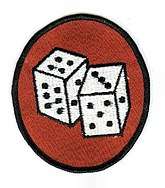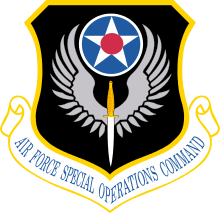65th Special Operations Squadron
The 65th Special Operations Squadron is an Air Force Special Operations Command unit which flies the MQ-9 Reaper, currently stationed at Hurlburt Field, Florida. It was first activated in 1941 as the 65th Bombardment Squadron when United States increased its armed forces prior to entry into World War II. It briefly served in the antisubmarine role, then deployed to the Southwest Pacific Theater, where it participated in combat against Japan, earning a Distinguished Unit Citation and a Philippine Presidential Unit Citation. During this period, a crew from the 65th became the most-decorated aircrew in United States history, when their B-17 fought off more than a dozen Japanese fighters during a photo reconnaissance mission.[3] The 65th remained in the Philippines after the war ended, and was inactivated in the Philippines in 1946.
65th Special Operations Squadron  | |
|---|---|
 MQ-9 Reaper as operated by the squadron | |
| Active | 1941–1946; 1946–1970; 1986–1991; 2018–present |
| Country | |
| Branch | |
| Role | Special Operations Persistent Attack and Reconnaissance |
| Part of | Air Force Special Operations Command |
| Nickname(s) | Lucky Dicers |
| Motto(s) | Scientiam Fortuna Iuvat |
| Engagements | Antisubmarine Campaign Southwest Pacific Theater[1] |
| Decorations | Distinguished Unit Citation Air Force Outstanding Unit Award Philippine Presidential Unit Citation[1] |
| Insignia | |
| 65th Bombardment Squadron emblem (approved 9 September 1954)[2] |  |
The squadron was reactivated at Davis-Monthan Field, Arizona as a Strategic Air Command bomber squadron. It continued in the strategic bomber role until 1970, flying a variety of strategic bombers, including the supersonic Convair B-58 Hustler. In 1962, a crew from the 65th won the Mackay Trophy and the Bendix Trophy for setting a trio of transcontinental speed records in a round trip from Los Angeles to New York and back during Operation Heat Rise.[4] From 1986 to 1991, as the 65th Strategic Squadron, it controlled bombers and tankers deployed at Anderson Air Force Base, Guam. It was activated in its current role in December 2018.
History
World War II
Activation and antisubmarine patrols
Combat in the Southwest Pacific Theater
Strategic Air Command
Early SAC operations
B-58 operations
The squadron moved to Carswell Air Force Base without personnel or equipment on 15 April 1960. At Carswell, it was manned and equipped from the 3958th Combat Crew Training Squadron and 6592d Test Squadron, which were discontinued.[5] The squadron immediately began training crews on the Convair B-58 Hustler and on 1 August began participating in Category III testing (operational testing) of the Hustler.[6]
Control of SAC units in the Pacific
Air Force Special Operations Command
Lineage
- Constituted as the 65th Bombardment Squadron (Heavy) on 20 November 1940
- Activated on 15 January 1941
- Redesignated 65th Bombardment Squadron, Heavy on 21 September 1943
- Inactivated on 29 April 1946
- Redesignated 65th Bombardment Squadron, Very Heavy and activated on 1 October 1946
- Redesignated 65th Bombardment Squadron, Medium on 2 July 1948
- Inactivated on 31 January 1970
- Redesignated 65th Strategic Squadron on 7 April 1986
- Activated on 1 July 1986
- Inactivated on 2 October 1991
- Redesignated 65th Special Operations Squadron on 26 September 2018
- Activated on 17 December 2018[1]
Assignments
- 43d Bombardment Group, 15 January 1941 – 29 April 1946
- 43d Bombardment Group, 1 October 1946
- 43d Bombardment Wing, 16 June 1952 – 31 January 1970
- 43d Strategic Wing (later 43d Bombardment Wing, 1 July 1986
- 376th Strategic Wing, 1 July 1990 – 2 October 1991
- 1st Special Operations Group, 17 December 2018 – present[1]
Stations
|
|
Aircraft
- North American B-25 Mitchell, 1941
- Boeing B-17 Flying Fortress, 1941–1943
- Consolidated B-24 Liberator, 1942–1945
- Boeing B-29 Superfortress, 1946–1950
- Boeing B-50 Superfortress, 1948–1954
- Boeing B-47 Stratojet, 1954–1960
- Convair B-58 Hustler, 1960–1970
- Boeing B-52 Stratofortress, 1986–1991
- Boeing KC-135 Stratotanker, 1990-1991[1]
- MQ-9 Reaper, 2018-
References
Notes
- Haulman, Daniel L. (15 November 2018). "Factsheet 65 Special Operations Squadron". Air Force Historical Research Agency. Retrieved 23 December 2018.
- Maurer, pp. 245-246
- ""Old 666"/"Lucy" – A History". Zeamer's Eager Beavers. 23 February 2014. Retrieved 23 March 2019.
- "Operation Heat Rise". National Museum of the US Air Force™. Retrieved 23 March 2019.
- Knaack, p. 384
- Knaack, p. 383
Bibliography
![]()
- Maurer, Maurer, ed. (1983) [1961]. Air Force Combat Units of World War II (PDF) (reprint ed.). Washington, DC: Office of Air Force History. ISBN 0-912799-02-1. LCCN 61060979. Retrieved 17 December 2016.
- Knaack, Marcelle Size (1988). Encyclopedia of US Air Force Aircraft and Missile Systems. Vol. 2, Post-World War II Bombers 1945-1973. Washington, DC: Office of Air Force History. ISBN 0-912799-59-5.
- Maurer, Maurer, ed. (1982) [1969]. Combat Squadrons of the Air Force, World War II (PDF) (reprint ed.). Washington, DC: Office of Air Force History. ISBN 0-405-12194-6. LCCN 70605402. OCLC 72556.
- Ravenstein, Charles A. (1984). Air Force Combat Wings, Lineage & Honors Histories 1947-1977. Washington, DC: Office of Air Force History. ISBN 0-912799-12-9. Retrieved 17 December 2016.
External links
- Kensmen: 43rd BG (H), 5th AAF Bomb Group of the WWII-era 65th BS


.svg.png)